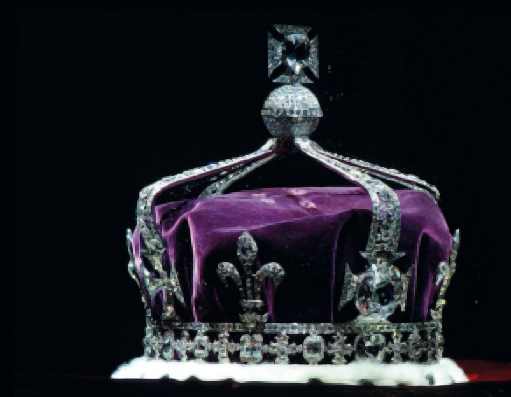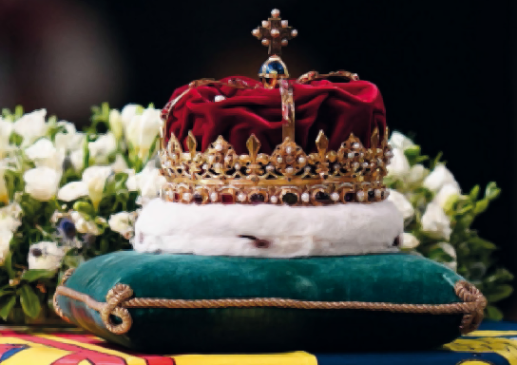On 2 June 1953, Queen Elizabeth II was crowned during a three-hour-long ceremony of pomp, pageantry and almost 1000-year-old tradition at Westminster Abbey. She was officially inaugurated into office when she received the glittering St Edward’s Crown upon her head: the chief symbol of regal authority. Buckingham Palace has now confirmed that the coronation of her son, King Charles III will take place on 6 May 2023 in Westminster Abbey.
Although the new King’s coronation ceremony is expected to look markedly different from the Queen’s, reflecting the new sovereign’s vision for a smaller, more modern monarchy, the main aspects of the ceremony will still be rooted in longstanding tradition. These traditions, which remain almost unchanged since they were first performed for the coronation of William the Conqueror in 1066, will see King Charles III take the Coronation Oath, be anointed with consecrated oil, receive the orb and sceptres, and have the St Edward’s Crown placed on his head by the Archbishop of Canterbury.
But this will not be the only crown we will see during May’s coronation ceremony. We can expect to see three highly symbolic and heavily bejewelled crowns used during the service, each with their own representations and unique history. In fact, there are four crowns in total in the British Royal Regalia, one of which has not been used in a coronation since 1651 and which has its own special position elsewhere. Here, we take a closer look at each of the crowns, their fascinating history, and how they are traditionally used during coronation ceremonies.
St Edward’s Crown
Only used once in the lifetime of each monarch — at their coronation — the St Edward’s Crown is the most important and sacred of the four crowns.
This specific crown was made for the coronation of King Charles II to replace the medieval version that had been melted down by parliamentarians in 1649, after the execution of King Charles I. This lost crown was said to have belonged to King Edward the Confessor, the last Anglo-Saxon King of England. Although the newer version is not an exact replica, it follows the original with four crosses-pattée and fleurs-de-lis, and two arches. The crown has a solid gold frame weighing 2.23kg and is set with rubies, amethysts, sapphires, garnet, topazes, and tourmalines. We will see the St Edward’s Crown at the coronation of King Charles III, when it is placed on his head at the pinnacle of the ceremony, symbolising his regal authority and signalling a trumpet fanfare and a gun salute outside the Abbey.
The Imperial State Crown
The other crown we will see King Charles wearing during his coronation ceremony, and perhaps the most familiar of all the Crown Jewels, is the Imperial State Crown. This is the crown that the monarch exchanges for the St Edward’s Crown at the end of the coronation ceremony.
This is because, before the Civil War, the ancient coronation crown was always kept at Westminster Abbey and the monarch needed another crown to wear when leaving the Abbey. The Imperial State Crown is also used on other State occasions, including the annual State Opening of Parliament, and recently was placed on the coffin of Queen Elizabeth II during her lying-in-state and funeral. The name of the crown dates from the 15th century, when a crown design closed by arches was chosen to demonstrate that England was not subject to any other earthly power.

Made of gold and set with 2,868 diamonds, 17 sapphires, 11 emeralds, 269 pearls, and four rubies, the Imperial State Crown also contains some of the most famous jewels in the entire Royal Collection. This includes the Black Prince’s Ruby, which, at 170 carats, is thought to have been the ruby given to Edward, Prince of Wales (1330-76), known as the Black Prince. This was one of the stones worn by Henry V in his helmet during his famous victory against the French at Agincourt.
Also on the crown is the Cullinan II diamond, which is the largest stone cut from the Cullinan Diamond, the largest diamond ever discovered. The St Edward’s Sapphire, which is set in the centre of the topmost cross, is said to have been worn in a ring by St Edward the Confessor and was discovered in his tomb in 1163. The crown that was worn by Queen Elizabeth II, and will be worn by King Charles III next spring, was made in 1937 for the coronation of the Queen’s father, King George VI and was designed to be lighter and fit better than the crown it replaced, which dated back to Queen Victoria. Nevertheless, it still weighs in at a hefty 1.06kg.
The Crown of Queen Elizabeth
The third crown that we expect to see during the coronation is the Crown of Queen Elizabeth, which was made in 1937 for the consort of King George VI and mother of Queen Elizabeth II.
The Queen Consort, Camilla, will be crowned alongside The King on 6 May, and the Crown of Queen Elizabeth is expected to be placed on her head. Camilla will be the first consort to be crowned since the Queen Mother in 1937; as a man, Prince Philip was not entitled to be crowned in the same way. Legend has it that the Koh-i-Nûr diamond, which sits on the front cross of the Crown of Queen Elizabeth, would bring misfortune if worn by a man. However, though the curse wouldn’t apply to Camilla, it’s still possible she will choose another crown for the ceremony.

The crown is set with 2,800 diamonds, most of which were removed from Queen Victoria’s Regal Circlet. The Koh-i-Nûr diamond, meaning ‘Mountain of Light’ in Persian, is one of the most famous diamonds in the world, and weighs 105.6 carats. It probably originated from the Golconda mines in central southern India, and has a turbulent history, with many previous owners, including Moghul Emperors, Shahs of Iran, emirs of Afghanistan, and Sikh Maharajas. In 1849, to mark the end of the Anglo-Sikh Wars in the Punjab, the jewel was surrendered to Queen Victoria. After the coronation of her husband, Queen Elizabeth The Queen Mother wore this crown at State Openings of Parliament and again at the coronation of her daughter, Queen Elizabeth II, in 1953.
The Crown of Scotland
The Crown of Scotland is the only crown of the four that we are not expecting to see at the coronation of King Charles III – it has not been used for a coronation since that of Charles II at Scone in 1651 (the last coronation in Scotland). The crown is part of the Honours of Scotland (which also includes the sword and sceptre) – the oldest royal regalia in the British Isles.

The Crown of Scotland was made in its present form for James V in 1540, having been refashioned from a damaged, lighter crown. James wore it to his consort’s coronation in the same year. Made from Scottish gold and weighing 1.64kg, the crown is encrusted with 22 gemstones and 20 precious stones and also features freshwater pearls from Scotland’s rivers. The crown was first used as part of a monarch’s coronation for the nine-month-old Mary, Queen of Scots in 1543, and then for her son James VI (and I of England) at Stirling in 1567, and grandson Charles I in 1633.
After Oliver Cromwell failed to stop the coronation of Charles II in 1651, he pursued the Honours to Dunnottar Castle, determined to destroy them just as he had the English regalia. He failed, however, and they were smuggled out for safe burial until Charles II’s restoration in 1660.
Following the Union of 1707 when the new United Kingdom Parliament met in London, the Honours had no ceremonial role and they were locked away in the Crown Room of Edinburgh Castle, where they have been on public display since 1819. In September, the Crown of Scotland was placed on top of Queen Elizabeth’s coffin as it lay-in-state at St Giles’ Cathedral before she left Scotland for the final time to be buried in London. However, we will have to wait to find out whether it will have a role alongside the other three crowns in the coronation of King Charles, on 6 May 2023.

